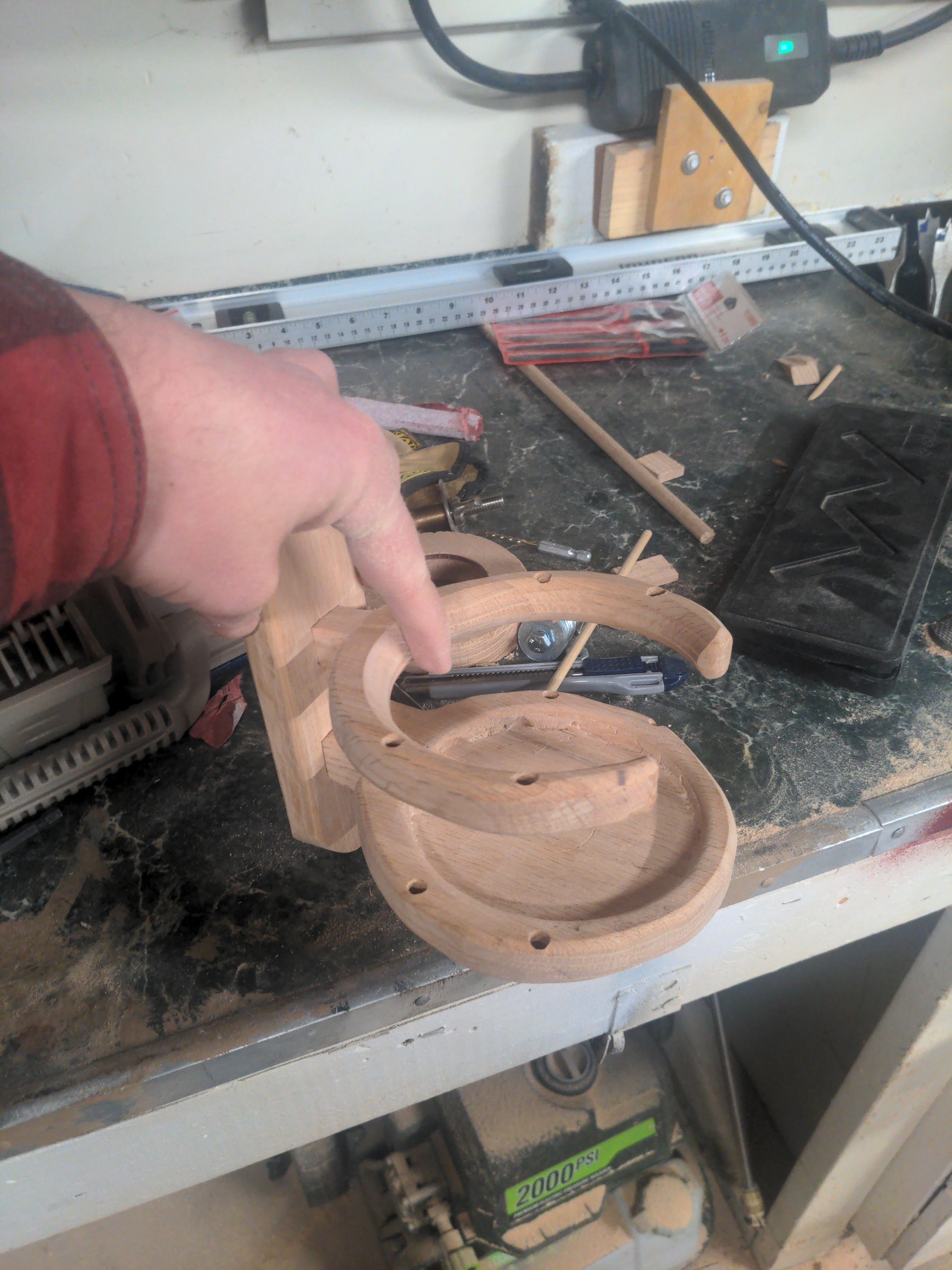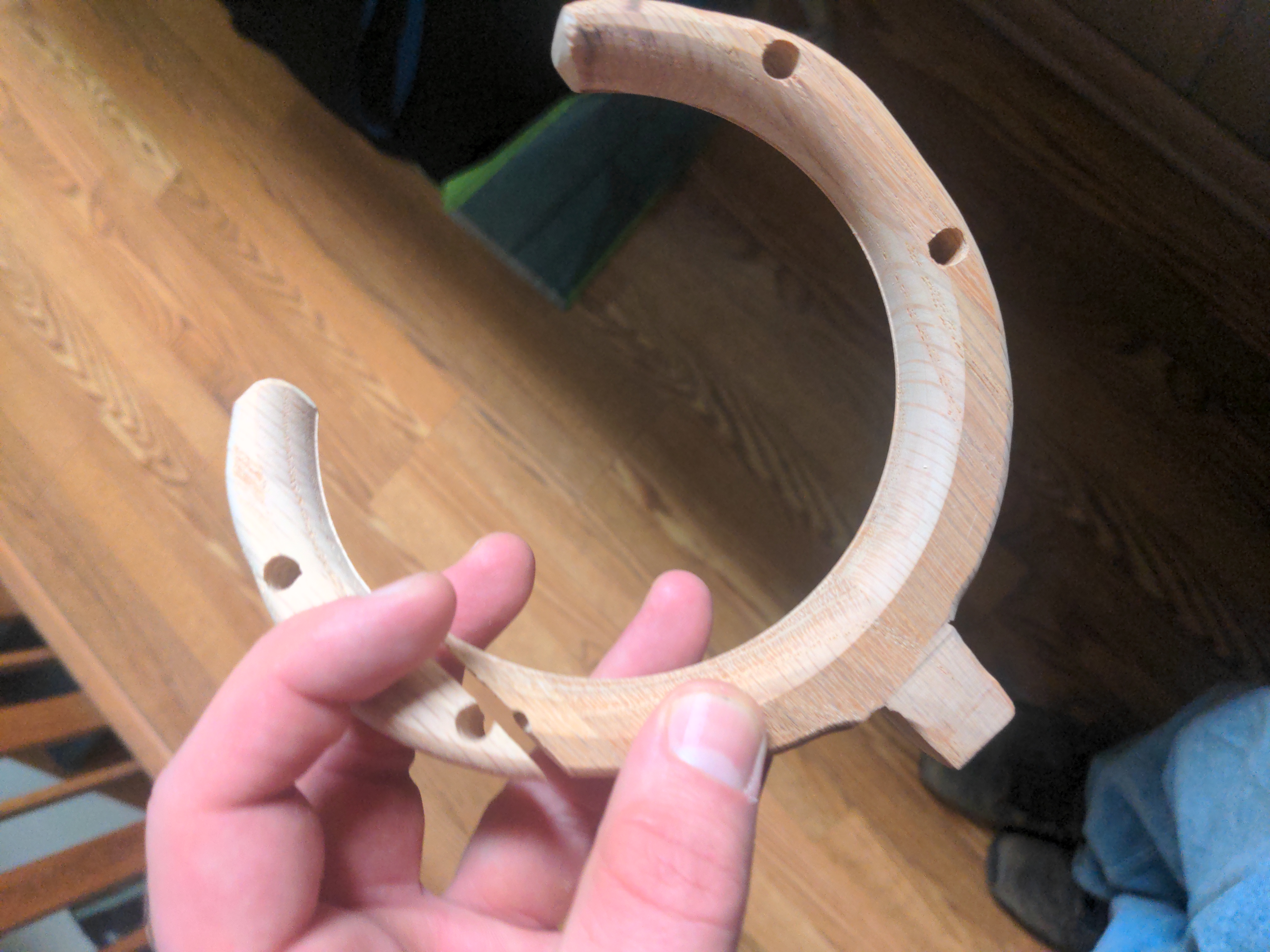Discussion sur les systèmes magiques
Return to Hittite religion: Teteshapi's cult and worship. Secret Words
Hi Karlie, you found the secret!
(If you're not Karlie, you also found the secret, but the secret is that it is a secret santa thing)
You got a standing desk a while ago, and I remember seeing that it would tilt up, and thinking that it might be nice to have a cupholder where you can put a drink down when the table isn't flat.
So anyway, I started to make that. Here's the general idea:

I wanted there to be something to guard against knocking the drink off, so I looked into bending wood with Ammonia. There were some websites that suggested it, but when I tried it with some scraps, it wasn't super successful.
So I thought of trying with steam, but also I had some oak shelves that were glued together, so that was easy. And I imagine that it would last pretty well if it can survive the glue-up.
But... It did not survive.

But the idea (which isn't in the pictures, I suppose), is that it would have two thumb screws: one to clamp onto the table, another that acts as a hinge (there is a brass sleeve to give a good hinge). You can tighten the hinge to keep it level at whichever angle you like.
So... if you'd find that useful, I can finish it up. I might use the existing holder as a mount point and use some thin slats that I can bend. Or just the same design but a little beefier. Let me know.
1) In the bilingual Hattian-Hittite texts of CTH 73314 where there is an indi cation of the names with which the divinities are called "among mankind" (Hittite: dandukisnilHattian: haw/piw/punan) and those with which they are called "among the gods" (Hittite: DINGIRme5-nas/n istarna/Hattian: hawashaw/pi); a few priests (L°NAR, L°GUDUi2), who are able to under stand this language, transmit it to mankind during specific rituals maltessar (see, for example, KUB 8.41 obv. II13': "this is in compliance with the ritual of the Storm-god", ke-e-ma-as-ta DISKUR-as ma-al-te-es-na rha-an-t[a-a an; or KUB 31.143 obv. II17:" [this] is in compliance with the ritual of Inara", [...] x DI-na-ra-as ma-al-te-es-na-as ha-an-da-a-an [...).15
In celebrations of the festival purulliyas, originating in the city of Nerik and for which in Hattusa at least 32 tablets were stored (cf. label KUB 30.421 5-6)22, the songs and dances of the MVNXJSMESzintuhes girls and the LVMEShapes men had a unusual space, as did the performances of the main officiant, the priest ess NIN.DINGIR, who appeared alone or accompanied by a young girl defined as "daughter of a poor man", DUMU.MUNUS 1ÜMÄSDA, this individual con stituting a clear reference to the second version of the myth of Illuyanka (the reference is certain because these are the only attestations to such an individual in Hittite literature
This journey entailed the transfer of the simulacrum of the goddess Teteshapi, accompanied by her priestess who carried out celebrations for the gods venerated in the local temples - in particular the temple of Telipinu at Tawiniya - and who used the arzana house as her main place of reference.25
It is actually at Tawiniya, after a series of ceremonies inside and outside the temple of Telipinu (recorded in the Middle Hittite tablet KBo 25.155 + KBo 24.98 + KBo 21.103 + KUB 32.83 and duplicates;26 KBo 21.90), among them the famous bull-leaping depicted on the smaller vase ofHiiseyindede27 and the ritual meal,28 that the NIN.DINGIR exhibits herself together with the daugh ter of the poor man of the mythological memory, as attested in the Illuyanka myth, in a dance accompanied by songs of the MmuSMESzintuhes girls and per formances of the lüMEShapes men, culminating in a great song of exaltation to the goddess in the Hattian language performed by the MUNUS,MESz»zfw/7es.29 At the end of the songs, dances, and mimed actions, which all contribute to the creation of profoundly ecstatic climate, the NIN.DINGIR lays out the ceremonial vestments, drinks the divinity and carries out the sacrificial round on her carriage. When the NIN.DINGIR retreats to the arzana, Teteshapi re sponds to the invocations that have been addressed to her and
"The "sasa- (and) the lamb are on the hankuri-. When I go, be afraid for me regarding the leopard and the wolf! lariya- the water!"
When I go there, fear me! I am the leopard and the wolf! Fear the water and behold Teteshapi!
NIN.DINGIR: the priestess of Teteshapi
- the gods have their own language;
- this language is a complex and solemn one;
- only their holy men are capable of transmitting it to mankind;
- verbal communication from the gods is extremely rare;
- the gods resort to using it with the sole purpose of revealing their divine essence to mankind


